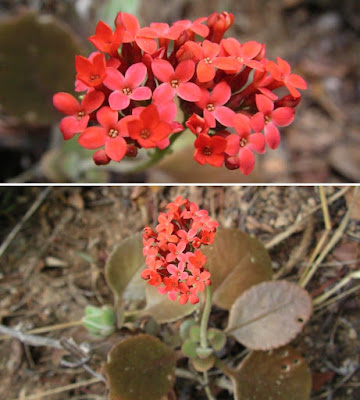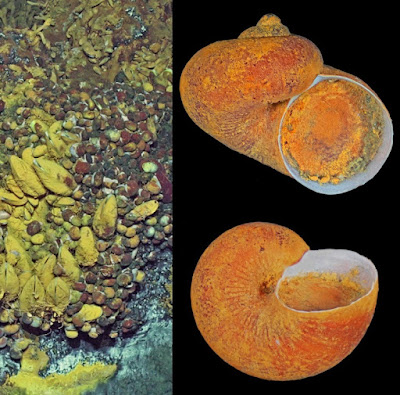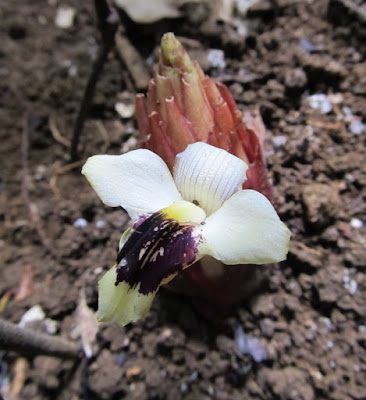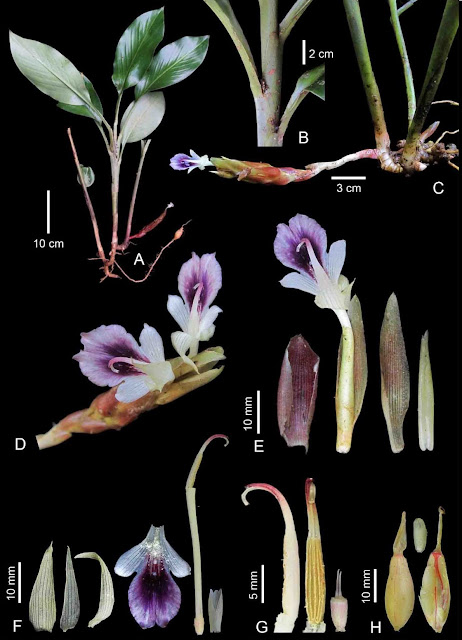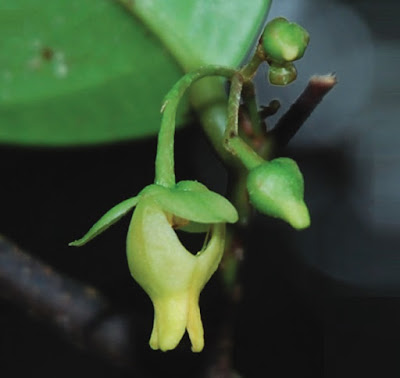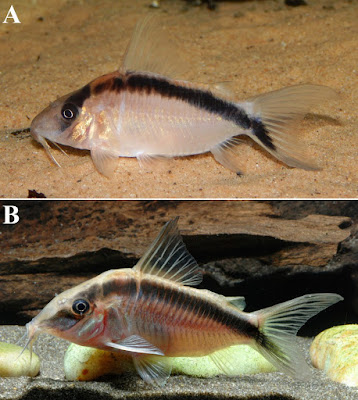[Most Recent Entries] [Calendar View]
Monday, June 28th, 2021
| Time | Event | ||||
| 6:18a | [Botany • 2021] Kalanchoe darainensis (Crassulaceae) • A New Species from northeastern Madagascar
Abstract A new species of small, rosulate and upright-flowered Kalanchoe Adans. (Crassulaceae) from northeastern Madagascar is described and illustrated: Kalanchoe darainensis D.-P. Klein & Callm. Morphologically, Kalanchoe darainensis is most similar to Kalanchoe blossfeldiana Poelln. and Kalanchoe globulifera H. Perrier which are known from the northwestern Tsaratanana Massif, c. 100 km southwest of Daraina. Detailed notes on the habitat and ecology of Kalanchoe darainensis are provided, as well as a short taxonomical overview of allied species of the Kalanchoe subg. Kalanchoe from Madagascar, including an identification key to those species. Despite its restricted distribution in the protected Antsahabe massif, the new species is preliminary assessed as “Least concern” [LC] using the IUCN Red List Criteria. KEYWORDS: Crassulaceae, Kalanchoe, Madagascar, Daraina, Loky-Manambato, new species David-Paul Klein, Ronen Shtein, Louis Nusbaumer and Martin W. Callmander. 2021. Kalanchoe darainensis (Crassulaceae), A New Species from northeastern Madagascar. Candollea. 76(1); 117-123. DOI: 10.15553/c2021v761a12 | ||||
| 2:37p | [Mollusca • 2021] Lirapex felix • A New Peltospirid Snail (Gastropoda: Neomphalida) adds to the Unique Biodiversity of Longqi Vent Field, Southwest Indian Ridge ABSTRACT The biodiversity of deep-sea hydrothermal vents in the Indian Ocean remains poorly characterised compared with that of their Pacific and Atlantic counterparts. Although the Longqi hydrothermal vent field is the most extensively explored vent site on the ultra-slow-spreading Southwest Indian Ridge, it is still a source of new discoveries. Here, we report and formally describe a new peltospirid snail from Longqi – Lirapex felix sp. nov. Known from only two specimens, it differs from other named Lirapex species by a depressed spire and the lack of coil loosening on the body whorl. Examinations of the external anatomy and radular characteristics agree with its placement in Lirapex, which is also supported by a molecular phylogeny reconstructed using the barcoding fragment of the mitochondrial cytochrome c oxidase I (COI) gene. This is the fifth peltospirid snail known to inhabit the Longqi field, three of which (including Lirapex felix sp. nov.) have been found nowhere else. There is growing evidence that the Longqi field represents a biogeographically unique site among Indian Ocean vents. The discovery of Lirapex felix sp. nov. adds to the unique biodiversity of Longqi field, with implications for conservation in the light of potential deep-sea mining. KEYWORDS: deep sea, hydrothermal vent, Indian Ocean, Mollusca, new species Lirapex felix sp. nov. Chong Chen, Yuru Han, Jonathan T. Copley and Yadong Zhou. 2021. A New Peltospirid Snail (Gastropoda: Neomphalida) adds to the Unique Biodiversity of Longqi Vent Field, Southwest Indian Ridge. Journal of Natural History. 55(13-14); 851-866. DOI: 10.1080/00222933.2021.1923851 | ||||
| 2:40p | [Botany • 2021] Zingiber magang & Z. tamii (Zingiberaceae) • Two New Species from central Vietnam
Abstract Zingiber magang and Z. tamii, two new species of Zingiber sect. Cryptanthium (Zingiberaceae) from central Vietnam are described and illustrated. Information on their distribution, ecology, phenology, uses and vernacular names are provided. A preliminary IUCN conservation assessment of each of these species is proposed. A key to species of Zingiber sect. Cryptanthium in Vietnam is also given. Keyword: Annamite range, endemic species, monocots, taxonomy, Zingiber sect. Cryptanthium
Zingiber magang N.S.Lý & Škorničk. sp. nov. Zingiber magang is rather distinct from its congeners by combination of leafy shoots composed of only 3–5 prominently petiolate leaves with weakly plicate and somewhat shiny leathery laminae, and inflorescences with basal part of basal bracts convex and slightly inflated giving it somewhat bullate appearance. Vernacular names and uses: This species is locally known as magang (Kinh minority), Pagieng or Pagang (Co, Ca Dong and Hre minorities). Rhizomes of this species are harvested, crushed and applied for healing wounds and bone fractures. Etymology: The specific epithet “magang” is derived from the common name applied to this species by local people from Kinh tribe in Quảng Ngãi province Zingiber tamii N.S.Lý & Škorničk. sp. nov. Similar to Z. vuquangense N.S.Lý et al. by overall similarity in leafy shoots consisting of prominently petiolate, broadly elliptic and prominently plicate laminae, but differs by overall smaller size 0.5–0.7 m, shorter ligules 3–5 mm long, smaller abaxially glabrous laminae 15.8–21.5 × 7.5–9.5 cm, narrowly ovate bracts, shorter calyx 10–12 mm long, pale yellow and externally sparsely puberulous corolla lobes, pale yellow lateral staminodes and ovate to elliptic ovate very dark purple labellum with small yellow blotches and yellow margin (compared to larger size 1.2–1.8 m, ligules 12–30 mm long, larger laminae abaxially densely pubescent along midrib 26–50.8 × 9–14.7 cm, oblong to club-shaped bracts, longer calyx 17–18 mm long, bright yellow and glabrous corolla lobes, lateral staminodes yellow with pink purple apex and obovate pink-purple labellum with pale yellow spots in Z. vuquangense). Distribution and habitat: Near streams and in the moist and shady understorey of primary and secondary tropical broadleaved forests between 520–930 m elevation. Eponymy: This species is named in honour of Mr. Trương Quang Tâm, a forestry engineer at Institute of Tropical Biology. Ngọc-Sam Ly, Dang-Giap Do, Ngọc-Giang Cao, Ba-Vuong Truong, Van-Thanh Nguyen and Jana Leong-Skornickova. 2021. Zingiber magang and Z. tamii (Zingiberaceae), Two New Species from central Vietnam. Taiwania. 66(2); 232‒240. | ||||
| 2:41p | [Botany • 2021] Orophea sichaikhanii (Annonaceae) ต่างหูคลองเงิน • A New Species from southern Thailand, with A Key to the Species of Orophea in Thailand and Notes on Some Species
Abstract Background and aims – Recent botanical expeditions in Ranong Province, southern Thailand yielded unidentifiable collections of Orophea subgenus Sphaerocarpon (Annonaceae). To elucidate the taxonomic status of these collections, detailed morphological examinations and comparisons with morphologically similar species are made. Material and methods – This study followed standard practices of herbarium taxonomy. Specimens of Orophea spp. in BKF, CMUB, L, and QBG herbaria were studied. Digitised type specimens deposited in BM, E, G, K, and L herbaria were accessed. A stereo microscope was used for morphological observations and measurements. Key results – A new species Orophea sichaikhanii is described and illustrated. The Peninsular Malaysian O. hastata and O. kingiana are the species most similar to the new species. Orophea sichaikhanii is different from O. hastata in several traits: indumentum on ovaries and young twigs; length of pedicels, inner petals, and inner petal claw; and inner petal colour and tip. The new species differs from O. kingiana by having dissimilar colour and tip of inner petals; lower number of stamens and carpels per flower; and glabrous ovaries. Additionally, a key to the species of Orophea in Thailand and notes on certain species are provided. Keywords: Annonaceae, Miliuseae, morphology, new species, Orophea, subgenus Sphaerocarpon, systematics, taxonomy, southern Thailand Orophea sichaikhanii Damth., Aongyong & Chaowasku, sp. nov. Etymology –This species is named after Geerawit Sichaikhan, who collected the specimens. He is an electrical engineer, but has a strong interest in plant diversity, especially in the area where he was born and has lived (Ban Khlong Ngoen). Anissara Damthongdee, Kithisak Aongyong and Tanawat Chaowasku. 2021. Orophea sichaikhanii (Annonaceae), A New Species from southern Thailand, with A Key to the Species of Orophea in Thailand and Notes on Some Species. Plant Ecology and Evolution. 154(2); 307-315. DOI: 10.5091/plecevo.2021.1780 | ||||
| 2:43p | [Ichthyology • 2021] Corydoras bethanae • A New Arc-striped Species of Corydoras Lacépède, 1803 (Siluriformes: Callichthyidae) from the Peruvian Amazon Abstract A new Corydoras is described from the Blanco and Ucayali river basins in Peru. The new species can be distinguished from its congeners by having the following features: (I) posterior margin of dorsal-fin spine with laminar serrations directed towards the origin of the spine; (II) a long, wide, arched, and continuous black stripe, which runs parallel to the dorsal profile of the body, extending at least from the region below anterior origin of dorsal fin to the anterior half of the ventral caudal-fin lobe; (III) a black stripe transversally crossing the eye, forming the typical mask-like blotch; mask clearly not fused to arched stripe in most specimens; some specimens with mask separated from arched stripe by a thin line around the suture between neurocranium (in the region composed by the posteroventral margin of parieto-supraoccipital plus the posterodorsal margin of the compound pterotic) and first dorsolateral body plate; (IV) posterior margin of pectoral-fin spine with laminar serrations directed towards the origin of the spine; (V) pointed snout, presenting a long mesethmoid, with anterior tip larger than 50% of the entire length of the bone; and (V) ventral surface of trunk covered by small, non-coalescent platelets. A discussion on the possible positive adaptive value of the arc-striped color pattern is also provided. Keywords: Pisces, Aposematism, Corydoradinae, mimicry, río Blanco, taxonomy Rebecca Frances Bentley, Steven Grant and Luiz Fernando Caserta Tencatt. 2021. A New Arc-striped Species of Corydoras Lacépède, 1803 (Teleostei: Callichthyidae) from the Peruvian Amazon. Zootaxa. 4948(2); 184–200. DOI: 10.11646/zootaxa.4948.2.2 |
| << Previous Day |
2021/06/28 [Calendar] |
Next Day >> |
